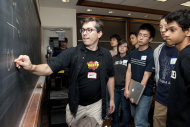By Selena Larson | Business 2 Community – Mon, Oct 21, 2013 7:45 PM EDT
-
By Selena Larson | Business 2 Community – Mon, Oct 21, 2013 7:45 PM EDT
Learning to code is all the rage these days, but not in one place that matters a lot: U.S. schools.
U.S. students already significantly lag their global counterparts where math and science skills are concerned. But computer science is in even worse shape: Of 12 technical subjects 
Schools Aren’t Teaching Kids To Code (Here’s Who Is Filling The Gap)examined in a recent study by the National Center for Education Statistics, computer science was the only one that declined in student popularity from 1990 to 2009 (p. 49).
Last year, just 1.4 percent of high school AP students took the computer science exam, compared to almost 40 percent that took exams in English. Far more students took AP exams in Spanish language, psychology, calculus, and history than in programming.
Insufficiencies in school can translate into a bigger problem on an economic level. Each year, U.S. companies need to fill almost150,000 jobs related to computer science and mathematics, but colleges and universities only graduate about 100,000 students with degrees in those fields.
Bridging the gap
Recognizing the need for an increased focus in computer science courses in schools, organizations like the nonprofit Code.org are teaming up with industry leaders to promote technology education in both elementary and high schools across the country.
Code.org believes all students in America should have the opportunity to learn computer science, and recently announced the first step in its plan to educate them. The Hour of Code initiative is a one-hour introduction to computer science, designed to help kids and educators understand coding. The organization will provide both online and “unplugged,” or paper, tutorials and materials designed to assist teachers with the education process.
“Bringing computer science to every kid is the gift the tech industry needs to give back to America,” Code.org cofounder Hadi Partovi said during the Hour of Code launch event on Monday.
The Hour of Code will take place during Computer Science Education Week, December 9-15, and will encourage teachers to include one hour of computer science in that week’s curriculum. The organization is using game-like tutorials including Angry Birds and Plants vs. Zombies to drum up excitement for coding in the classroom.
Code.org is supported by leaders in technology and education including Bill Gates, Mark Zuckerberg, former president Bill Clinton, NBA star Chris Bosh, and actor Ashton Kutcher.
Paypal cofounder Max Levchin said that teaching young students how to code is critical for maintaining economic competitiveness in the 21st century.
“I think learning how to code, learning how the vast majority of everything around them works, literally, that is to say Internet of Things, and many other trends like it,” he said. “Having that knowledge will prepare children in the generations to come to participate in the economic development of the world.”
A prep school shows the way
To meet the growing need for computer science literate individuals, Beaver Day Country School, an independent college prep middle and high school just outside Boston, now requires students to have coding experience in order to graduate. Rather than requiring students take a standalone coding course to graduate, Beaver’s educators are incorporating coding practices into classes like math, science and even English.
“We also recognize that coding is a mindset, so we don’t want our students to memorize a certain list of commands within a certain programming language,” said Rob MacDonald, the school’s math department head. “Instead, we want them to think about solving problems in innovative ways.”
Learning programming and computer science builds problem-solving skills and critical thinking that can inform other walks of life.
“We’re also planning an interdisciplinary project in which students will learn about the history of surveillance, including the recent controversies around the NSA and Wikileaks,” MacDonald said. “That project will incorporate history, English and math, and teachers from all three departments will work together on the curriculum.”
Beaver has witnessed the success of coding firsthand. Last fall, a group of students from the Beaver InvenTeam received a $10,000 grant from the Lemelson-MIT program to build “an automated robot vehicular independence system,” or a robot that can follow motion sensors while carrying up to 50 pounds of weight. The school will begin implementing the coding classes for upperclassmen, but will expand all the way down to sixth-graders in the future.
Of course, Beaver Day’s approach isn’t for everyone—tuition for the 2013-2014 school year is $39,950, and the school enrolls a total of 457 students—but it’s definitely an intriguing model.
A teaching shortage
While the idea of mandating computer science classes on the path to graduation is an impressive notion, many schools and organizations are finding it challenging to educate and keep teachers who develop technical skills. “I can say pretty confidently there are multiple challenges, but the biggest by far is the lack of teachers,” Code.org’s Partovi said.
To make up that shortage, many students turn to mentors or peers outside the classroom to assist with projects like building websites or mobile applications.
“I know some students that say, ‘I would have loved to learn more about technology, but my friends, teachers or parents didn’t know much about it’,” said Edward Jiang, CEO and founder of StudentRND. “Building an app was far off magic that no one understood.”
Jiang started StudentRND, an organization that inspires the next generation of technologists and encourages people to work on projects in their free time, after teaching himself how to build websites and online games in high school.
He noticed that many students don’t have the time or the place to explore topics like programming. So he created Code Day, a 24-hour event that brings together high school and college students to build projects.
Because of his program and others like it, students get the opportunity to connect with peers and mentors that share their passion for computer science and can build and develop projects they would have struggled with pursuing on their own.
StudentRND and Code.org both recognize the importance of qualified mentors as an impetus for students to pursue interests in computer science.
“My first exposure to code and programming was actually in a neighborhood workshop,” said Levchin, who grew up in the Soviet Union. “But it’s remarkable that a backwards country like the Soviet Union had [resources for] learning how to code. And industry people, and software developers from the defense program that were teaching kids how to code.”
By 2020, computer-related employment is expected to rise by 22 percent. That means students must be ready to enter a workforce that expects them to have polished technological skills.
Lead image via HackNY on Flickr, other media via Code.org
